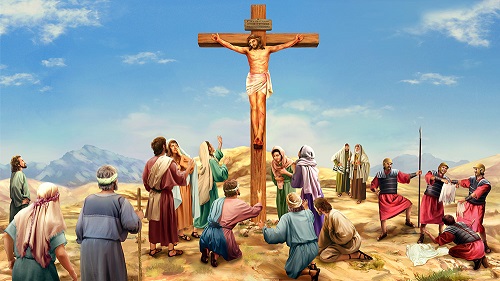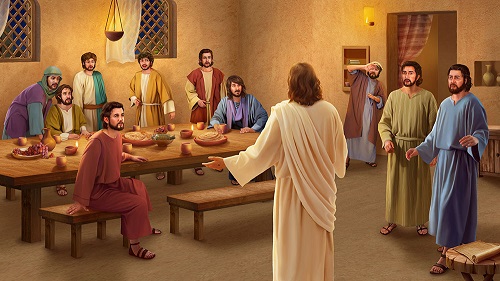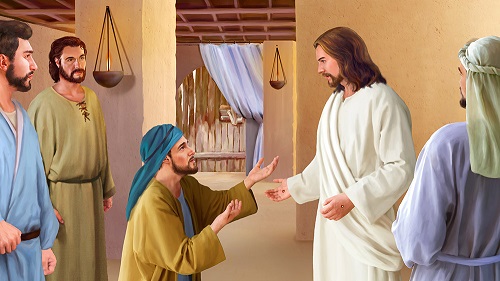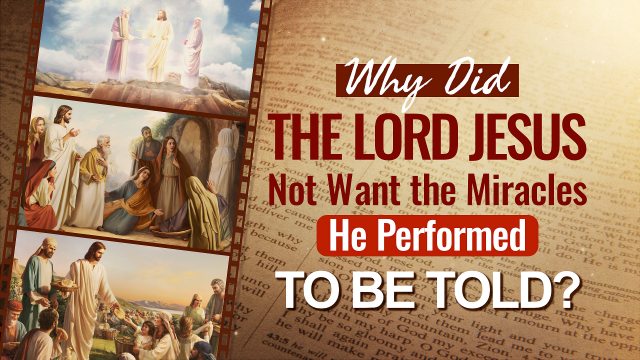The Diverse Meanings of the Lord Jesus' Resurrection

One day, I turned on my computer and opened a web page casually. An exquisite egg caught my eye, beneath which there were some lilies and a rabbit made of chocolate. It turned out that Easter was coming soon. As is recorded in the Bible, the origin of Easter is as follows: Jesus Christ, after the betrayal of one of His disciples, was taken to the court and then nailed to the cross on Friday for redeeming the world by the willing sacrifice of Himself. According to the Jewish law, Saturday was the Sabbath when all activities must cease. So the followers of Christ could only hastily place His body in a grave by the sunset of Friday, and then hurried off. On Sunday morning, people went back to the grave, only to find the body of Jesus disappeared, and then they were told that Jesus Christ had been resurrected. Since then, the Christians have called the Sunday in memory of Jesus Christ’s resurrection Easter. This is the origin of Easter.
I couldn’t help but think: What are the diverse meanings of the Lord Jesus’ resurrection? To work it out, I opened the Bible and quickly found chapter 24, verses 1-9 of the Gospel of Luke, which I read frequently, and then started to read in a low voice, “Now on the first day of the week, very early in the morning, they came to the sepulcher, bringing the spices which they had prepared, and certain others with them. And they found the stone rolled away from the sepulcher. And they entered in, and found not the body of the Lord Jesus. And it came to pass, as they were much perplexed thereabout, behold, two men stood by them in shining garments: And as they were afraid, and bowed down their faces to the earth, they said to them, Why seek you the living among the dead? He is not here, but is risen: remember how he spoke to you when he was yet in Galilee, Saying, The Son of man must be delivered into the hands of sinful men, and be crucified, and the third day rise again. And they remembered his words, And returned from the sepulcher, and told all these things to the eleven, and to all the rest.”
In the eyes of man, when one dies, he will become a soul that makes others feel scared and a distance with him. Likewise, when people saw the Lord Jesus after His resurrection, their first reaction was supposed to fear, avoid, and evade Him. In this way, there would have been a large distance between man and the Lord Jesus, and man would have also been brought back to the age of the Old Testament when he believed in the invisible and intangible God. As a matter of fact, people indeed felt terrified when they first saw the Lord Jesus after His resurrection, but why did they later feel that He was intimate, rather than scary or strange? What was behind this?

Then I eagerly turned to chapter 24, verses 36-43 of the Gospel of Luke, “And as they thus spoke, Jesus himself stood in the middle of them, and said to them, Peace be to you. But they were terrified and affrighted, and supposed that they had seen a spirit. And he said to them, Why are you troubled? and why do thoughts arise in your hearts? Behold my hands and my feet, that it is I myself: handle me, and see; for a spirit has not flesh and bones, as you see me have. And when he had thus spoken, he showed them his hands and his feet. And while they yet believed not for joy, and wondered, he said to them, Have you here any meat? And they gave him a piece of a broiled fish, and of an honeycomb. And he took it, and did eat before them.” From these scriptures, we can see that God knows man’s weakness, and the fear in their hearts when they saw the spiritual body of the resurrected Lord. But as God loves and cares about man, He didn’t want to see man removing themselves from Him or putting Him at a distance. Hence, God thoughtfully appeared to man in His form of flesh and blood, not in a formless spiritual body. As I was reading, the scenes came to my mind little by little where the Lord Jesus appeared to His disciples following the resurrection and ate broiled fish with them. The Lord was so amiable, and I was brought closer to Him in an instant. I felt warmth in my heart, and even more an impulse. I wished that I could have lived in that time and personally witnessed the resurrected Lord Jesus. How blessed it would be! When the disciples saw all that happening, they must have felt the intimacy and loveliness of the Lord more than I did, as well as the incomparable joy of regaining something that has been lost. The Lord Jesus resurrected could still be seen and touched, was made of flesh and blood, and ate and drank with people, who was the same as the Lord Jesus that had not yet been crucified. So people could stay with Him again, no longer feared Him or felt strange with Him, and their relationship with the Lord Jesus was restored to the intimate relationship they had with Him when He was in the flesh. From this, we can see God’s unchanging hopes and concern for mankind, and also His meticulous care and cherishing of humans.
Then what is the significance of the Lord Jesus’ appearance to man after His resurrection? To figure it out, I took out a book I especially enjoyed reading, and found a refreshing passage, “The first thing that the Lord Jesus did after His resurrection was to allow everyone to see Him, to confirm that He exists, and to confirm the fact of His resurrection. In addition, this action restored His relationship with the people back to the way it was when He was working in the flesh, when He was the Christ whom they could see and touch. One outcome of this is that the people had no doubt whatever that the Lord Jesus had been resurrected from death after being nailed to the cross, and they also had no doubt in the Lord Jesus’ work to redeem mankind. Another outcome is that the fact of the Lord Jesus appearing to people after His resurrection and allowing people to see and touch Him firmly secured mankind in the Age of Grace, ensuring that, from this time on, people would not return to the previous Age of Law on the supposed basis that the Lord Jesus had ‘disappeared’ or that He had ‘left without a word.’ He thus ensured that they would continue to move forward, following the Lord Jesus’ teachings and the work He had done. Thus, a new phase in the work in the Age of Grace was formally opened, and from that moment on, the people who had been living under the law formally emerged from the law and entered into a new era, a new beginning. These are the multi-faceted meanings of the Lord Jesus’ appearance to mankind after the resurrection.” I had never seen such words in other spiritual books. These words directly and clearly explained the meanings of the Lord Jesus’ resurrection. While reading and pondering this passage, I understood that the Lord Jesus’ resurrection secured the work in the Age of Grace and opened up a new phase in it, and that people under the law were truly freed from the bondage of the rules and regulations and entered into a new era. Moreover, because of the fact that the Lord Jesus could be seen and touched after His resurrection, people no longer doubted His work and accepted it, and thus the curtain had formally risen on His work in the Age of Grace. If the Lord Jesus had not been resurrected, the work of God’s incarnation would have been buried by Satan, and man would not have believed His work during His time in the flesh or all the truths He had expressed. Therefore, the Lord Jesus’ resurrection was key in God carrying out His work in the new age. When people saw that the Lord Jesus was really resurrected from death and was certain that He was truly Christ, the Son of God, and the appearance of God, they hence had firm and unwavering faith in the work He had done, and began to spread His gospel, spreading it until the final age. Without the resurrection, the spread of the gospel in the Age of Grace would not have achieved results, and there would not have been so many saints who had sacrificed everything for it, unflinching and dauntless, wave after wave. In particular, the Lord’s disciples and apostles martyred themselves for Him and bore beautifully resonant testimony. These were all the results achieved by the Lord’s resurrection. The more I contemplated, the more brightened and inspired I felt inside. The Lord Jesus’ resurrection was so significant! Now I had gained a better understanding of the meaning of 1 Corinthians 15:17, “And if Christ be not raised, your faith is vain; you are yet in your sins.” The Lord Jesus’ resurrection was indeed the foundation of the faith of all Christianity; without it, there would not be faith in the Lord in the religious world.

At this point, I called to mind another question: Why did the Lord Jesus specially appear to Thomas after His resurrection and let him touch the nail marks on His body? I saw chapter 20, verses 26-29 of the Gospel of John, “And after eight days again his disciples were within, and Thomas with them: then came Jesus, the doors being shut, and stood in the middle, and said, Peace be to you. Then said he to Thomas, Reach here your finger, and behold my hands; and reach here your hand, and thrust it into my side: and be not faithless, but believing. And Thomas answered and said to him, My LORD and my God. Jesus said to him, Thomas, because you have seen me, you have believed: blessed are they that have not seen, and yet have believed.” And there are some words in the spiritual book saying, “Before the Lord Jesus was nailed to the cross, Thomas always doubted that He was Christ, and was incapable of belief. His faith in God was established only on the basis of what he could see with his own eyes, what he could touch with his own hands. The Lord Jesus had a good understanding of the faith of this type of person. They only believed in God in heaven, and did not believe at all in the One sent by God, or the Christ in the flesh, and nor would they accept Him. In order for Thomas to acknowledge and believe in the existence of the Lord Jesus and that He truly was God incarnate, He allowed Thomas to reach out his hand and touch His rib. Was Thomas’ doubting any different before and after the Lord Jesus’ resurrection? He was always doubting, and except by the Lord Jesus’ spiritual body personally appearing to him and allowing him to touch the nail marks on His body, there was no way that anyone could resolve his doubts and make him let go of them. So, from the time the Lord Jesus allowed Thomas to touch His rib and let him really feel the existence of the nail marks, Thomas’ doubt disappeared, and he truly knew that the Lord Jesus had been resurrected, and he acknowledged and believed that the Lord Jesus was the true Christ and God incarnate.” Only after I repeatedly pray-read these words and pondered them carefully, did I understand that the Lord Jesus before and after the resurrection was no different in essence. He is always the God who observes the depths of man’s heart and is fully aware of everyone’s thoughts, ideas, and mentality. He knew Thomas’ substance and nature. During the time when He worked in the flesh, He knew clearly that Thomas in his heart didn’t believe that He was the incarnate God, Christ. Besides, when He was nailed to the cross, Thomas didn’t believe that He would rise from death. In the eyes of Thomas, the dead could not be raised and resurrection was impossible. There were many people like Thomas. They only believed in the vague God in heaven and could not have genuine faith in the incarnate God. They had doubt about the Lord Jesus Christ. They verbally acknowledged the Lord was Christ, the Son of God, but could not see clearly and didn’t believe that He would be resurrected or that He was God incarnate. These people didn’t believe the Lord was truly resurrected even if they saw it with their own eyes, and they must touch the nail marks on Him to make sure of it; otherwise, they would not believe the Lord Jesus’ words, and even deny all that He said. In order to thoroughly convince Thomas, the Lord found him after the resurrection and let him touch His nail marks. Only when Thomas saw that the Lord Jesus came in with the doors closed and touched the nail marks on His body with his own hand, did he genuinely believe that the Lord Jesus had been resurrected from death, and that He was indeed God, the incarnate God. After it was proved, he didn’t have notions anymore. However, these words “Jesus said to him, Thomas, because you have seen me, you have believed: blessed are they that have not seen, and yet have believed,” allowed us to see that the Lord didn’t praise this kind of belief and didn’t acknowledge him as a person who followed God. Since it was only after he had seen the Lord Jesus resurrected that Thomas truly believed in Him, he forever missed the opportunity to follow and know Christ, and to be perfected by Him.
Why was Thomas always so doubtful about the Lord Jesus? It was because he didn’t have true knowledge about what the Lord Jesus expressed—the voice of God. Why could Peter recognize that the Lord Jesus was Christ, the Son of God? Because he could discern God’s voice. It seems that we cannot know Christ based only on what we see. If we rely solely on what we see with our eyes and don’t understand the truth expressed by God, we will never reach the goal of knowing God. We should know God’s disposition and discover the truth from God’s words. It is said in 1 Timothy 3:16, “And without controversy great is the mystery of godliness: God was manifest in the flesh, justified in the Spirit, seen of angels, preached to the Gentiles, believed on in the world, received up into glory.” The Lord Jesus is sure to come again. If He comes through incarnation and appears to man, are we able to know Him? Can we recognize God’s voice from His words like the wise virgins? …








